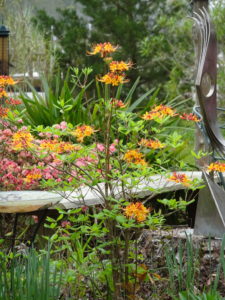Native Azaleas
go.ncsu.edu/readext?674139
en Español / em Português
El inglés es el idioma de control de esta página. En la medida en que haya algún conflicto entre la traducción al inglés y la traducción, el inglés prevalece.
Al hacer clic en el enlace de traducción se activa un servicio de traducción gratuito para convertir la página al español. Al igual que con cualquier traducción por Internet, la conversión no es sensible al contexto y puede que no traduzca el texto en su significado original. NC State Extension no garantiza la exactitud del texto traducido. Por favor, tenga en cuenta que algunas aplicaciones y/o servicios pueden no funcionar como se espera cuando se traducen.
Português
Inglês é o idioma de controle desta página. Na medida que haja algum conflito entre o texto original em Inglês e a tradução, o Inglês prevalece.
Ao clicar no link de tradução, um serviço gratuito de tradução será ativado para converter a página para o Português. Como em qualquer tradução pela internet, a conversão não é sensivel ao contexto e pode não ocorrer a tradução para o significado orginal. O serviço de Extensão da Carolina do Norte (NC State Extension) não garante a exatidão do texto traduzido. Por favor, observe que algumas funções ou serviços podem não funcionar como esperado após a tradução.
English
English is the controlling language of this page. To the extent there is any conflict between the English text and the translation, English controls.
Clicking on the translation link activates a free translation service to convert the page to Spanish. As with any Internet translation, the conversion is not context-sensitive and may not translate the text to its original meaning. NC State Extension does not guarantee the accuracy of the translated text. Please note that some applications and/or services may not function as expected when translated.
Collapse ▲
Photo Credit: Carolyn Hoss, Flame Azalea
We’ve all been enjoying the gorgeous blooms and colors of the many different Oriental azaleas that have been making a show here in late March and early April. Did you know there are native azaleas that can be found in our local forests and woods?
Azaleas are close relatives of the big Rhododendrons that make a beautiful show every spring in our mountains. In fact, “Rhododendron” is the proper botanical genus for azaleas. Here on the coast, there are at least three different species of wild or native azaleas. These are R. atlanticum or Coast Azalea, R. viscosum or Swamp Azalea, and R. nudiflorum or Pinxter flower. Both the Coast and Swamp azaleas are fragrant. Another native of the Southeast, but not of NC is the Florida or Flame azalea, R. austrinum which has spectacular red, orange, or yellow flowers and can look like a spark of flame in the landscape. It grows well in our area too.
All our native azaleas are deciduous or bare of leaves in the winter, and many will spread from the roots (stoloniferous) making a clump or grouping as they mature. As is true of all azaleas, natives need acid soil, are shallow rooted, and are at their best in light shade with regular watering. They also need a light mulch of pine straw or composted materials. If you have the right environment in your landscape, try a native azalea.
Written by Carolyn Hoss, Master Gardener℠ volunteer




